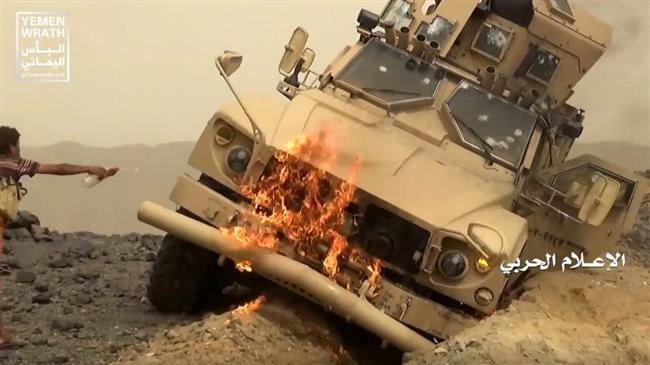Over the past few months, Yemen’s army forces and popular committees struck back at the aggression forces as the Saudi-led Arab coalition attacks continued.
Since 2018, Yemen has made significant progress in developing considerable capabilities to produce missiles and combat drones, resulting in victories to the Yemeni forces and despair to much-vaunted Saudi air defenses systems.
In recent years, Yemeni forces have repeatedly fired missiles at targets in Saudi territory and claimed responsibility for them. Recent attacks on the Armco oil facility, the bombing of some military airfields in Jizan in southern Saudi Arabia, and hitting some Saudi military bases and headquarters were the retaliatory attacks by the Yemeni army and Ansarullah revolutionary movement against the ongoing war, now in its sixth year.
Striking oil facilities
Yemen's missile and drone strikes on Saudi oil facilities mark a new chapter in the fresh escalation as the Saudi campaign continues.
Last month, the Saudi ministry of energy confirmed that a large oil tank was completely destroyed in the latest Yemeni military attacks on a petroleum products distribution station in Jizan. An official at the oil ministry called the Yemeni attacks a "sabotage operation." confirming the fire, in the station, the official claimed that the attack had no casualties.
Yahya Al-Saree, the spokesman to the Yemeni armed forces, told a press conference that the attacks reached the Saudi depth, adding that 8 ballistic missiles and 18 combat drones were involved in the retaliatory operation.
"Ras Tanura, Rabigh, Yanba, Yanbu, Jazan, and King Abdulaziz Airbase in Dammam were attacked by the Yemeni strikes," he further told the reporters in Sana’a.
Two weeks later, Reuters news agency reported, quoting the Saudi energy ministry, an oil storage area in Ras Tanura had been attacked by a drone. Ras Tanura is a region where the world's largest oil facilities are located, and therefore disruption of oil processing operations could have major economic implications for the oil-dependent Arab monarchy. It was the first time during the war that the Yemeni army decided to strike Al-Khobar and Ras Tanura oil facilities consecutively in the kingdom’s northeast and the Persian Gulf coast. The oil terminals, the world's largest of the kind, are responsible for reserving and exporting 7 million oil barrels daily through sea. They are 1,300 kilometers far from the closest area in Yemen under Ansarullah control.
Indeed, this was one of the several raids on the oil-wealthy Kingdom. The largest one came in summer of 2019 on Aramco oil terminals in the Persian Gulf coast, cutting oil production capacity by half for a couple of months.
Additionally, al-Saree in last fall said that Yemen's missile forces brought under their attacks Aramco distribution facilities in Jeddah with cruise missiles.
Specifically over the past six months, the Saudi oil industry sites in various parts of the country, from Jeddah and Ras Tanura to Jizan, came under Yemeni missile attacks that inflicted heavy damages on the aggression country.
Damages of missile attack on the capital Riyadh
With the Saudi coalition going on, Riyadh proved not immune to retaliatory Yemeni missile operations.
In March, the official spokesmen to the Saudi General Directorate of Civil Defense (GDCD), talked about the damages caused by a Yemeni missile attack on the capital. Claiming responsibility for the missile and drone operation, Yemeni forces said the attack also included a "Zulfaqar" ballistic missile.
"The fragments of these missiles hit several residential areas in different places and caused damage to a house, but there were no casualties," the GDCD spokesman admitted.
At the time, Wall Street Journal newspaper reported that the attacks on Riyadh inflicted damages on a significant royal building.
Operation Fifth Deterrence Balance
"Deterrence balance" is a set of operations carried out deep into Saudi Arabia by Ansarullah since 2019 in retaliation to unceasing Saudi air and ground attacks. The savage Saudi air attacks on the airports, economic arteries, and the remaining infrastructures provoked responses under deterrence balance operations that came in four stages, hitting Aramco and military airports across Saudi Arabia. The attacks were so hard that will remain memorable for years.
The fifth stage came in March in response to the enemy's heinous crimes in attacking civilians in Sana’a and other parts of Yemen, as well as continuing to support the fugitive President Abdrabbuh Mansour Hadi's mercenaries, despite strong warnings from the Yemeni army.
The last month missile and drone operation first covered southern Saudi cities. Three key air bases in the south, Khamis Mushait, Abha, and Najran which are responsible for providing logistics to the mercenary forces on Yemeni Ma’rib front, were targeted, according to al-Saree, by mixed attacks involving suicide Qasef-2K and Samad-3 drones, and 7 "Badr" artillery rockets. The Saudis claimed they intercepted 10 drones but only two unverified videos of interceptions were published.
Also, a projectile was fired at Jeddah port on the Red Sea coast on Monday. Saudi air defenses claimed interception without publishing details and evidence.
The essential point about these attacks was that they were aimed at targets and areas that were under heavy cover of the air defenses and the anti-aircraft guns.
Saudi war costs
So far various reports have been published to count the costs of the Saudi war on Yemen, ongoing since March 2015. David Hirst, a prominent British journalist and writer, says that since the start of war, Saudi Arabia lost around $232 billion of its reserves without knowing exactly where they have gone. The royal court have never explained what happened to the money but military analysts suggest it, which equals operating budget for such countries as Jordan and Tunisia for 18 years, has been spent in war on Yemen. To be precise, each day of anti-Yemeni campaign costs Saudi Arabia over $100 million.
/129

